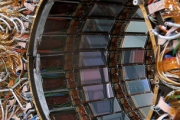Viewings: 4734

Physics of the European organization for nuclear research (CERN) has officially announced the opening of a new particle in the course of experiments at the Large hadron Collider, its properties are mainly expected for the Higgs boson, but some still different.
The Higgs boson is the last missing piece of the modern theory of elementary particles, the so-called Standard model, combining all kinds of interactions except gravity is strong (binds quarks into protons and neutrons), weak (the interaction between electrons and neutrinos), and electromagnetic. The fact of the existence of the Higgs boson, which is responsible for the mass of elementary particles, for the first time suggested the English physicist Peter Higgs in the 1960-ies.
"We are witnessing a new particle, we have strong enough evidence to talk about the opening" - stated the official representative of the CMS collaboration (team of scientists working on the CMS detector) Joe inkandela (Joe Incandela). His videogalerie was posted on Tuesday, on the CERN website.
According to the representative of the collaboration, scientists will need more time for additional analysis of the obtained data.
"This particle is very similar in its properties to the Higgs boson, but in some ways it is not exactly as expected... This may not be the Higgs particle, Standard model, and it looks like a particle" - he said.
If it so, it'll be a revolution in physics, the scientist said. For example, the result will be proved the theory of the existence of extra spatial dimensions. It is the most significant experimental discovery in the last 30-40 years, he added.
According to Incandela, it is a fundamental boson, he probably zero spin.
"This is the hardest part of all known, with the exception of the top quark, " said Incandela.
He noted that the new particle about a hundred times heavier than the proton.
Earlier, a source at CERN confirmed to RIA Novosti that the experts of the two "competing" collaboration of the Large hadron Collider, ATLAS, and CMS "see" new particle with mass 125-126 GeV with accuracy corresponding to the opening level.
According to the principles of the Standard model, at the moment of birth of the Universe after the Big Bang particles acquired mass under the action of a Higgs field, formed Higgs bosons. Without this field could not be formed of atoms, and particles that do not have a lot, just would fly on outer space. According to the theory, the elusive Higgs particles exist everywhere. Through the Higgs field that fills the space of the Universe, are all the particles that comprise atoms, molecules, tissues and whole organisms.
The search for the Higgs boson, which has received in the media name "God particle", the scientists of many countries. If the existence of the Higgs boson will not be confirmed, this will show the limitations of the Standard model. There will be a need for alternative theories of the origin of mass in accordance with the so-called new physics.
Theory is not useful to make a lot of boson, so for his discovery, scientists have resorted to the method of the experiment. The mass of particle physics is measured in units of energy - electronvolt. The mass value 100 GeV (GeV) in about 107 times the mass of the proton.
According to theoretical predictions, the Higgs boson decays immediately after birth to different particles. One way (channels") of such disintegration could be the collapse of two of the Z boson, four leptons (electron or muon), two gamma-quantum. Therefore, in experiments are registered particle - decay products of the Higgs boson, and already on them restored the picture of what happened.
The first serious attempt "catch" Higgs boson have been taken at the turn of the XX and XXI centuries on the Large electron-positron Collider (Large Electron-Positron Collider, LEP) at CERN.
As a result of numerous experiments at the LEP was set the lower threshold of the mass of the Higgs boson - to 114.4 GeV. The LEP experiments were completed in 2001.
The following cycles of searches conducted at the Tevatron Collider (Tevatron), built in 1983 in the Laboratory Fermi (Fermilab), in Illinois, USA. Energy collisions it was about 2 teraelectronvolt.
In 2004, the experimental method on the Tevatron was established upper limit of the mass of the Higgs particles - 251 GeV, and the lower - 114 GeV. In November 2011 figures were adjusted: 141 and 115 GeV, respectively.
Final results from the Tevatron, which completed its work in the autumn of 2011, showed that the Higgs boson mass is in the range from 115 to 135 GeV.
Scientists expect to find this piece (or to ensure that it does not exist) will allow experiments at the Large hadron Collider, created by scientists from many countries at the site CERN in the suburbs of Geneva (Switzerland). It is the largest in the history of the accelerator of elementary particles intended for obtaining fundamentally new information about the nature of matter and the fundamental physical laws. One of the main purposes of the experiments at the Large hadron Collider (LHC) - the search for evidence of the existence of the Higgs boson.
Physicists working with the Large hadron Collider, on Wednesday at the workshop, CERN in Geneva will present data on the new particle. The official representatives of the ATLAS and CMS, Fabiola Gianotti and Joe inkandela respectively, will tell about the latest news in the search for the Higgs boson. The seminar will be attended Peter Higgs, and other scientists who contributed to the development of the so-called Higgs mechanism that explains the origin of mass, Francois Angler, Gerald Guralnick and Carl Hagen.
















